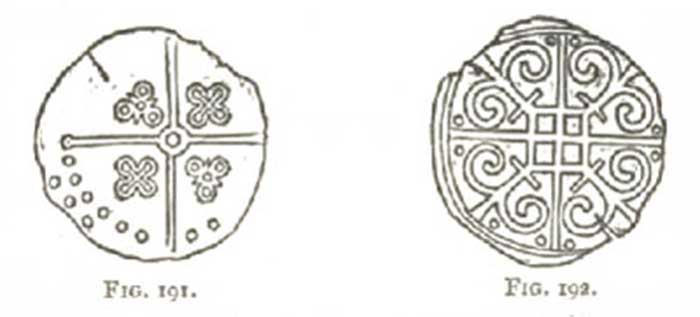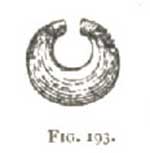Standards of Value and Mediums of Exchange in Ancient Ireland
From A Smaller Social History of Ancient Ireland 1906
« previous page | contents | start of chapter | next page »
CHAPTER XXIII....continued
4. Standards of Value and Mediums of Exchange.
In early stages of society in Ireland, as in all other countries, buying and selling and other commercial transactions were carried on by means of payment in kind: and there is hardly any description of valuable articles that was not used for this purpose. Payments were made for purchases, tribute, fines, &c., in cows, sacks of corn, salted pigs, butter, mantles, and so forth: the parties determining the values according to the customs of the place. But mixed up with this barter in kind, gold and silver, told out by weight, and—after the middle of the eighth century—silver coins, were used as mediums of exchange.
That the Irish were acquainted with the use of coined money, at least as early as the eighth century, is proved by the records: but whether they coined money for themselves before the tenth century is a matter that has not been determined.
FIGS.191 & 192. Irish bracteate Coins: now in National Museum, Dublin. (From Petrie's Round Towers).
The coins in circulation among the Irish were the pinginn and the screpall [skreppal], both of silver. The pinginn weighed 8 grains of wheat, equal to 6 grains Troy: the screpall was equal to 3 pinginns, i.e. 18 grains Troy.
Many specimens of the pinginn and of the screpall are preserved in the National Museum. The pinginns are what are called "bracteate" coins, i.e. struck only on one side; but the screpalls are impressed on both sides.
From the very beginning of our records gold and silver were used as a medium of exchange, sometimes as ingots, but more commonly in the form of rings, bracelets, and other ornaments. They were weighed by the ounce, which, as we have seen, was equal in weight to 576 grains of wheat, or to 432 grains Troy. In order to facilitate interchange of this kind, gold and silver rings of various forms, as well as other gold and silver ornaments, were generally or always made of definite weights. Notices of this custom are found everywhere in Irish literature. So also Caesar records that in his time the people of Britain "used brass or iron rings fixed at a certain weight as their money." But in Ireland, gold, as being comparatively abundant, was used instead of the inferior metals. The custom of making gold ornaments after a fixed weight seems to have been general among all civilised nations of antiquity.
FIG. 193. Gold Bunne or Ring: open, but without the do-ats. Used as money. Now in the National Museum. (From Wilde's Catalogue).
It may be considered certain that in Ireland the open gold rings called bunne-do-at (now often called fibula: articles, were used as money. But besides those see p. 412, supra) as well as other gold ornamental called bunne-do-at, there are in the National Museum a great number—fifty or more—of very small open gold rings, from ¼ to ¾ inch in diameter, without the terminal knobs or ats: these are bunnes simply, not bunne-do-ats. From their great numbers, and from their simple, unornamental construction, they have all the appearance of having been used mainly as currency.
A full-grown cow, or ox, was in ancient times a very general standard of value, not only in Ireland, but all over the civilised world: and was considered equal in value to one ounce of gold. In this use—as an article of payment—a cow was in Ireland generally called a séd [shade]. Cows or séds were very often used both in actual payments and in estimating amounts. Next above the séd was the cumal, which was originally applied to a bondmaid: but the word came to be used very generally to signify the value of a bondmaid, which was counted as three séds, or cows.
A miach or sack of corn—generally of oats or barley—which for convenience sake must have been always made of uniform size—was very often used as a standard of value: it is indeed adopted in the Brehon Law as the almost universal standard in estimating fines for trespass, and payments for grazing.


